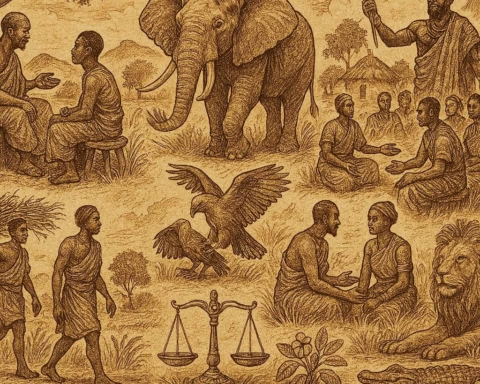The terror beneath the waters
Long ago, in the deep waters of Lake Abaya, there lived a fearsome creature known as the Seven-Headed Serpent. This monstrous being ruled the lake with its many heads, each one snapping fiercely and spitting deadly venom. The people of the surrounding villages feared the serpent for it devoured fish, destroyed boats, and threatened anyone who dared approach the water. Parents warned their children to stay far from the lake, for the serpent’s wrath was swift and unforgiving.
The young hero’s vow
One day, a brave young man named Kassa grew tired of living in fear. He vowed to face the serpent and free his people from its terror. Armed with a spear blessed by the village elders, Kassa set out toward Lake Abaya. As he approached the shimmering water, the serpent rose from the depths, its seven heads hissing and twisting like snakes. The battle began with thunderous roars and fierce strikes, shaking the earth and water alike.
The sacrifice for victory
Kassa fought valiantly, but the serpent’s many heads made it nearly impossible to defeat. Realizing he could not win with strength alone, he remembered the elders’ words about sacrifice and courage. With a heavy heart, Kassa offered himself to the lake spirit. As he plunged his spear into the serpent’s central head, he called upon the spirits to accept his life to save his people. The serpent let out a final deafening roar and sank beneath the waves, defeated.
The lasting peace and legend
Though Kassa’s body was never found, the people celebrated his sacrifice and the peace that followed. The waters of Lake Abaya grew calm, and fish returned in abundance. Kassa became a hero remembered in songs and stories, a symbol of bravery and selflessness. To this day, villagers honor his memory with ceremonies by the lake, reminding themselves that courage and sacrifice protect their homes.
Moral Lesson of The Seven-Headed Serpent of Lake Abaya
This story teaches that true heroism requires courage and sometimes sacrifice for the greater good. It shows how facing fears and giving for others bring peace and safety to the community.
Knowledge Check
- What is the moral of the folktale The Seven-Headed Serpent of Lake Abaya?
The story teaches courage and sacrifice showing how selflessness protects and restores peace. - What cultural group does the tale The Seven-Headed Serpent of Lake Abaya come from?
This folktale originates from the Ethiopian tradition. - Why did Kassa decide to face the serpent?
Kassa wanted to free his people from fear and danger caused by the serpent. - How does the folktale The Seven-Headed Serpent of Lake Abaya explain lake monsters?
It describes lake monsters as powerful forces that test human bravery and require respect or sacrifice. - Is The Seven-Headed Serpent of Lake Abaya a ghost story origin tale trickster story or spirit tale?
It is a spirit tale reflecting Ethiopian beliefs about natural forces and heroic sacrifice. - Why is the tale The Seven-Headed Serpent of Lake Abaya still meaningful to modern readers?
The story remains relevant because it teaches timeless values of bravery sacrifice and protecting the community.
Cultural Origin
This folktale comes from the traditional beliefs and storytelling practices of the Ethiopian people around Lake Abaya.






